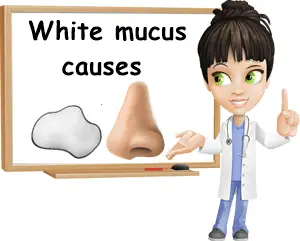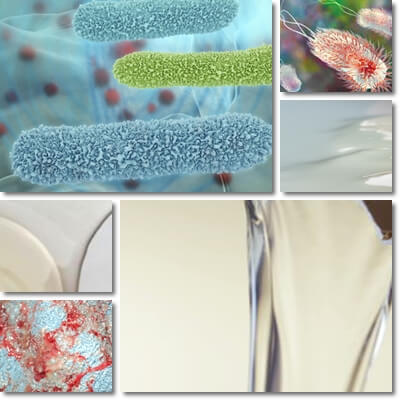Mucus is a byproduct of normal metabolism and serves important purposes in the human body. For example, it contains antibodies which help fight infection. It is rich in water that maintains moisture and prevents sensitive mucous membranes from drying up and allowing infections to occur more easily. Mucus also helps trap bacteria and viruses and remove them from the body as well as inactivate some of the allergens we may come into contact with.
Mucus can contain dirt, dust, irritants and other particles that may try to enter the body and possibly produce infection and disease. It lessens friction in order to smooth movement and overall exerts a protective role over mucous membranes throughout the body. What most people don’t know is that mucus is produced everywhere in the body where there is a mucous membrane, such as in the nose, mouth, eyes, airways, stomach or intestinal tract. And its appearance is one of the most important indicators of good or bad health.

Learning to recognize what normal mucus looks like and identifying any changes it may undergo are some of the first steps in assessing your health. Any changes in appearance, consistency, smell, amount or other characteristics of mucus can tell you if there is something wrong and whether or not it may be time to see a doctor for further investigations. And it usually is clear even to the least trained eye when a doctor visit is in order. Nose and throat mucus are the two most telling indicators of respiratory system health.
Usually, mucus from throat caused by a medical condition is called phlegm or sputum if it’s coughed. Mucus from nose is distinguished from throat mucus and is simply called nasal mucus. Catarrh refers to mucous discharge from both nose and throat. For the most part, nose and throat mucus can have the following colors: clear, white, yellow, green, gray, black, pink, reddish, rusty, brown or black (read more about mucus color: what it means).
White mucus from nose and throat is of particular interest because it can mean many things, from infection and allergies to chronic disease. And depending on the amount produced and other characteristics as well as potential accompanying symptoms, it reveals a lot about your health. Find out next what are the most surprising 7 causes of white mucus and what it means for your health.

Most common causes
1) Allergies. Seasonal pollen allergies and allergies to environmental allergens such as pet hair, mold or dust cause allergic rhinitis, or hay fever. When allergens enter the nose from the air, not only do they produce irritation locally, but the immune system also activates against them. This triggers the production of excess mucus to trap the allergens and prevent them from going deeper into the respiratory system.
Usually, mucus from allergies is clear and abundant, some people describing it as an egg white type of mucus. If dust or dirt are the cause, it may be streaked with gray or black. But if the exposure to the allergen is extensive, the immune system response is strong as a result and there are high levels of inflammation which could result in the production of a relatively dense white mucus in the nose. As a result of postnasal drip, a symptom common to allergic rhinitis and which causes nose mucus to drip into the throat, white mucus could appear in the back of the throat and mouth too.
2) Milk and dairy products. Excess milk and dairy products are known to cause a dense throat mucus. This is because dairy products make mucus thicker which makes it harder for the body to drain it. The longer the mucus stays there, the more it changes, taking on an opaque white color. Eating too much wheat can also cause a thick, sometimes white mucus in the throat.
3) Gastritis, gastroesophageal reflux (GERD). Wherever there is a mucous membrane, there is mucus produced to protect it. For example, the esophagus requires protection as it facilitates the passing of food into the stomach, the purpose being to reduce friction. But if you have acid reflux or gastritis, highly erosive stomach juices often escape into the esophagus and burn through the mucus coating, causing extensive irritation and damage to the mucous membrane.
In an effort to counteract the damage, the body will increase its mucus production and often generate a thicker, clear mucus that could better coat the sensitive lining. But as a result of the extensive inflammation and the body’s attempts to repair the damaged cells, the mucous can sometimes be whitish in color. Foods that are too spicy can produce a similar irritation to the esophagus and similar side effects (read more about what foods to eat and to avoid for gastritis and the best and worst foods for acid reflux).
4) Common cold. White mucus in the nose and throat is often a sign of a common cold. It usually starts out clear in color and rather runny, which is also why it drips in the back of the throat and ends up in the mouth from where it is either coughed as sputum or ingested. But as the infection progresses, it will change color and consistency, becoming white and thicker, then yellow or green in the more advanced stages of the infection. The change in mucus color does not always warrant the need for medication, so it’s best to see your doctor and have him or her run tests to confirm a bacterial infection before anything else.
If what you have is really a common cold, there should be other symptoms such as: sore throat, runny nose, sneezing, stuffy nose, coughing, in some cases a slight fever. Symptoms are usually gradual and should resolve in a week or so. The difference between the common cold and the flu is the flu often cause aches, sore muscles, headaches, usually a stronger, more resilient fever, with symptoms starting out suddenly and progressively getting worse. The difference between the common cold and allergies is the common cold tends to resolve itself in a week or so, while allergies often persist for weeks.
5) Other respiratory infections: ear infection (otitis), tonsilitis, sinusitis, bronchitis. Any form of respiratory infection starts out with a clear, then white mucus. As the infection progresses, the mucus can turn yellow, green or even darker and complications may arise. A sinusitis can last for months, while a bronchitis can evolve into pneumonia. More serious respiratory conditions should be recognized by the accompanying symptoms and gradual change in mucus color.
6) Dry, irritated throat from dehydration, smoking or vocal cords distress. White throat mucus is indicative of extensive inflammation. Dry throat caused by dehydration, exposure to irritants, smoking, talking too much, shouting or vocal cords distress from smoking, excessive talking or singing are all potential causes of white mucus in throat. Air pollutants also have a similar effect, drying out the throat and causing irritation and excess mucus.
7) Chronic disease. Asthma, chronic bronchitis, cystic fibrosis, chronic obstructive pulmonary disease etc. can cause excess mucus production, including white mucus.
White mucus: home-remedies and treatment options
1) Drinking plenty of water facilitates mucus elimination and reduces mucus production by washing down allergens and gastric juices, relieving nasal congestion and calming throat irritation.
2) Acidic foods break down thick mucus. Adding a bit of lemon juice or eating small amounts of other acidic citrus fruits breaks down mucus, making it easy for the body to eliminate it. But remember acidic foods cause teeth sensitivity and may worsen gastritis.
3) Honey and lukewarm herbal teas help calm throat irritation and eliminate mucus (example: ginger tea). But make sure you are not allergic to honey and bee products or herbal tea plants.
4) Avoid allergens (pollen, dust, foods etc.) to prevent excess mucus production.
5) Reduce intake of milk, dairy and wheat products.
6) Manage GERD and gastritis with dietary, lifestyle changes and medication if needed.
7) If symptoms indicate an infection that requires treatment, see a doctor for appropriate treatment and follow your doctor’s instructions as advised.
8) Cough when you feel like you have to. Do not force it, but do not avoid it either. Coughing may help free sticky mucus from mucous membranes and allow you to eliminate it.
9) Steam helps loosen mucus and facilitates its elimination. Steam from a running shower could help improve mucus problems. If the air is too dry where you sleep, a humidifier can help.
10) Eating a warm chicken soup can help hydrate airways and dislocate mucus from throat. Drinking a cup of warm herbal tea of your choice can be just as effective, especially if you add a few drops of fresh lemon juice.
